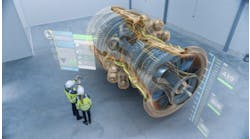Training real-world skills in augmented and virtual realities
Honeywell recently introduced an industrial-training solution that combines 3D-immersive technology with operator-training simulation to create a collaborative learning environment for plant operators and field technicians. This Immersive Field Simulator is a virtual reality (VR) and mixed reality-based training tool that incorporates a digital twin of the physical plant to provide targeted, on-demand, skill-based training for workers, according to Honeywell.
Cool stuff. We wanted to learn more, so we connected with Vincent Higgins, general manager for Honeywell’s digital transformation/workforce competency business with Honeywell Process Solutions.
Take a look…
Smart Industry: How is 3D tech changing the way we train the industrial workforce?
Vincent: Despite being around for more than 30 years, virtual reality is just now beginning to catch on in the industrial environment. Advances in computing power and the advent of VR devices have brought virtual reality into a practical place in our lives.
From a workplace perspective, VR has vastly expanded the possibility of how workers are trained. These platforms make it possible to put employees in almost any location or situation imaginable, interacting with items that would otherwise be difficult or impossible to have in a training environment.
Employing a headset, VR users are immersed in a virtual world, whereas augmented-reality applications superimpose layers of graphic information on their field of view. These technologies can be paired in a technique known as mixed reality to transcend distance, time and scale and expand comprehension, collaboration and decision-making. Whereas AR is seen as an emerging technology, it is representative of Industry 4.0’s ability to unify the physical and digital worlds, and likewise, the public and private spheres.
The foremost application domain of VR and AR has been in education since the 1990s; it has been used to teach subjects like mathematics, geometry, physics, chemistry and anatomy. In the past few years, VR has been applied in virtual training. For instance, a virtual plant-operator training module is being used to train plant personnel to handle emergencies. In maintenance, AR has been used for repairing and servicing complex systems such as hydraulic breakers.
While there is significant potential for immersive learning in training frontline, entry-level and middle-skill workers, dramatic adoption of the technology is occurring across a variety of industries, including highly specialized fields in the industrial field.
Thanks to advances in VR, these skills can be taught in a simulated classroom. Industries across all sectors have a growing need for education and training in the workplace, from detailed technical tasks to soft skills such as public speaking. Many of these skills benefit from the repeatability of virtual learning.
Tools developed by leading tech companies have been a boon for many industries. New platforms have been developed to train manufacturing workers faster, like a training simulation that Connecticut-based energy company Avangrid developed for wind-turbine technicians. Lenovo’s VR solution helps new hires get up to speed on repairing industrial machinery. Office work has also seen a similar training boom: Accenture, the global consulting giant, uses VR to share recruitment techniques.
Smart Industry: How has the pandemic affected this trend?
Vincent: Since the spring of 2020 we’ve all been witnesses to how today’s strained environment continues to impact the manufacturing industries. From remote-operations solutions to social-distancing technologies, every facet of the industry is adjusting to the new realities of manufacturing.
Today, in-person learning experiences are on hold, which may make VR training truly mainstream. With so many people working from home, engaging and training a newly remote workforce is a priority for companies. Global market intelligence firm IDC predicts the market for virtual and augmented-reality training will hit $8.5 billion in 2023, more than half of today’s total market for AR and VR ($16.8 billion).
“When you’re training with coworkers, there are still professional respect and filters there, which you won’t have with a simulated human,” says Scott Likens, an emerging tech leader at PricewaterhouseCoopers (PwC) who has studied VR training’s effectiveness. With VR goggles, employees can have a more immersive, multisensory and engaging experience, without the fear of screwing up in front of office mates. “It’s a safer space,” he says.
It’s also more time- and cost-effective. A PwC study found that VR students learn four times faster than classroom learners. At scale, it also saves companies money. Despite the upfront investment in technology and hardware, such as goggles and training software, a VR program is cost-competitive with classroom learning with 375 or more participants.
Smart Industry: Are younger workers more inclined to train/learn in the virtual space?
Vincent: According to the 70:20:10 framework, 10% of what people learn comes from formal learning events such as courses and classes; 20% comes from informal, peer-to-peer learning; and 70% is experiential. This means that what most people learn comes from on-the-job training, trial and error and simply learning by doing.
Since the workplace will soon comprise of almost entirely millennials, companies are finding more innovative ways to appeal to this tech-savvy demographic. And what better way to improve on-boarding and training with VR? It is commonly held that a majority of millennials have in interest in VR technology. Manufacturing industries are already ahead of the curve, in which safety and manufacturing skills training was the second-most popular application of VR and AR among U.S. manufacturers. VR provides scalable hands-on training without expensive and dangerous consequences.
Virtual models have proven to be highly effective for training students for success in technical disciplines such as electromechanical, mechanicals and plumbing technicians. Students can learn complicated repairs on large, complex machinery using software such as the programmable logic controller software. With VR, even more advancements in learning are expected to be seen.
As entire workforces have migrated online, it’s quickly become clear that big, international companies can keep their business running without a centralized, physical hub. That reality has sunk in for recent graduates, many of whom only need an internet connection to perform a job and don’t need to be tied down to a cubicle.
Smart Industry: How does VR enhance skill-retention?
Vincent: Since its introduction into the technology, entertainment and training sectors, VR has been sweeping into the minds and hearts of many tech enthusiasts. In fact, studies show that the use of VR in training can significantly increase retention.
Most what people learn comes from experiential learning, or “learning by doing.” VR provides an avenue to allow learners to get hands-on without actually executing on the job. Not only does this represent the majority of how staff learn, but it also represents a modality with high retention rates.
The concept of retention is fundamental to training and development—with good reason. With VR, senses, emotions and cognitive functions of the brain are engaged, tapping into the most powerful aspects of retention.
According to Dr. Narendra Kini, CEO at Miami Children’s Health System, the retention level a year after a VR training session can be as much as 80%, compared to 20% retention after a week with traditional training. “The level of understanding through VR is great because humans are primarily visual and VR is a visual format,” Kini says. “We believe there are numerous opportunities where repetitive training and skill set maintenance are critical for outcomes. Since there are not enough patients in many cases to maintain these skill sets, virtual reality is a real addition to the arsenal. Imagine also scenarios where we need to practice for accreditation and or compliance. In these situations, virtual reality is a god-send.”
As industrial and manufacturing positions increasingly fill with younger workers, it’s appropriate to make use of the technology that’s familiar to this generation. Accustomed to extensive and sophisticated gaming platforms, younger workers find it easier to make the transition from virtual reality safety training to real-world practices. Per a recent PWC survey, safety and manufacturing skills training was the second-most popular application of VR and augmented reality among US manufacturers.
VR is more memorable than live training, which is another key reason it enhances employee retention.
When it comes to using VR training, there are many methods available that will allow boosting employee retention. VR training is quickly becoming one of the most powerful learning technologies and should be considered a major advantage for companies’ corporate learning strategy.
Smart Industry: What most excites you about the near future of VR-based training?
Vincent: With the recent surge in VR-compatible smartphones, VR is quickly becoming a familiar name. Several applications of VR technology are already on the market. With so much perspective, the possibility of training by means of VR is stimulating. Industrial workers can use VR technology very effectively to train in processes and procedures. The VR environment will allow the learner to try and practice procedures without fearing the negative impact of a bad decision or lack of practice.
Contrary to popular belief, there’s a high demand for jobs in the manufacturing industries. The problem is not that many jobs have gone overseas, it’s that the jobs have gone high-tech, but the workers have not. In fact, American manufacturers have added nearly a million jobs in the past seven years.
The challenge in today’s modern manufacturing industry is to bridge the skills gap. While AR and VR technology can help train and onboard a new generation of workers in this industry, this is not enough. Emerging professionals need to acquire electro-mechanical training, for instance, through online certificate programs to develop in-demand skills for this modern industry amid the current pandemic.


